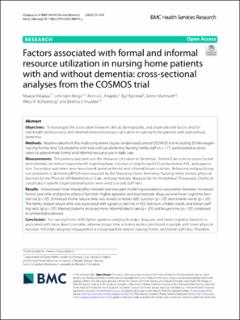| dc.contributor.author | Vislapuu, Maarja | |
| dc.contributor.author | Berge, Line Iden | |
| dc.contributor.author | Angeles, Renira Corinne | |
| dc.contributor.author | Kjerstad, Egil | |
| dc.contributor.author | Mannseth, Janne | |
| dc.contributor.author | Achterberg, Wilco | |
| dc.contributor.author | Husebø, Bettina Elisabeth Franziska | |
| dc.date.accessioned | 2022-12-08T08:15:05Z | |
| dc.date.available | 2022-12-08T08:15:05Z | |
| dc.date.created | 2022-11-17T12:43:09Z | |
| dc.date.issued | 2022 | |
| dc.identifier.issn | 1472-6963 | |
| dc.identifier.uri | https://hdl.handle.net/11250/3036634 | |
| dc.description.abstract | Objectives: To investigate the association between clinical, demographic, and organizational factors and formal (health professionals) and informal (relatives) resource utilization in nursing home patients with and without dementia.
Methods: Baseline data from the multicomponent cluster randomized control COSMOS trial including 33 Norwegian nursing homes and 723 residents with and without dementia. Nursing home staff (n = 117) participated as proxy raters to approximate formal and informal resource use in daily care.
Measurements: The primary outcome was the Resource Utilization in Dementia - Formal Care scale to assess formal and informal care time in hours/month regarding basic activities of daily living (ADL), instrumental ADL, and supervision. Secondary outcomes were hours/week spent on formal and informal leisure activities. Behavioral and psychological symptoms in dementia (BPSD) were assessed by the Neuropsychiatric Inventory-Nursing Home version, physical function by the Physical Self-Maintenance Scale, and psychotropic drug use by the Anatomical Therapeutic Chemical classification system. Organizational factors were ward size and staff ratio.
Results: Generalized linear mixed-effect models and two-part modelling revealed an association between increased formal care time and poorer physical function, higher agitation and psychotropic drug use and lower cognitive function (all p < .05). Enhanced formal leisure time was related to better ADL function (p < .05) and smaller wards (p < .05). The family related leisure time was associated with agitation, decline in ADL function, smaller wards, and better staffing ratio (all p < .05). Married patients received more informal direct care (p < .05) and leisure time (p < .05) compared to unmarried/widowed.
Conclusion: For nursing home staff, higher agitation and psychotropic drug use, and lower cognitive function, is associated with more direct care time, whereas leisure time activities are less prioritized in people with lower physical function. Informal caregivers’ engagement is encouraged by smaller nursing homes and better staff ratio. Therefore, we recommend stakeholders and healthcare professionals to consider these clinical and organizational factors to optimize treatment and leisure time activities in nursing home patients with various needs. | en_US |
| dc.language.iso | eng | en_US |
| dc.publisher | BMC | en_US |
| dc.rights | Navngivelse 4.0 Internasjonal | * |
| dc.rights.uri | http://creativecommons.org/licenses/by/4.0/deed.no | * |
| dc.title | Factors associated with formal and informal resource utilization in nursing home patients with and without dementia: cross-sectional analyses from the COSMOS trial | en_US |
| dc.type | Journal article | en_US |
| dc.type | Peer reviewed | en_US |
| dc.description.version | publishedVersion | en_US |
| dc.rights.holder | Copyright 2022 the authors | en_US |
| dc.source.articlenumber | 1306 | en_US |
| cristin.ispublished | true | |
| cristin.fulltext | original | |
| cristin.qualitycode | 2 | |
| dc.identifier.doi | 10.1186/s12913-022-08675-y | |
| dc.identifier.cristin | 2075558 | |
| dc.source.journal | BMC Health Services Research | en_US |
| dc.identifier.citation | BMC Health Services Research. 2022, 22, 1306. | en_US |
| dc.source.volume | 22 | en_US |

